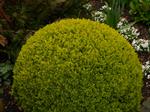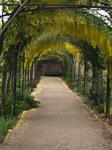Plant Sculpting
 For something unique in your garden, why not sculpt your plants into shapes that reflect your personality. In this article, we tell you how to create shapely plants that will delight visitors to your garden.
For something unique in your garden, why not sculpt your plants into shapes that reflect your personality. In this article, we tell you how to create shapely plants that will delight visitors to your garden.
Topiary
Topiary, or sculpted plants are popular features of traditional style gardens. Traditionally, topiary is created by training one or several plants to grow over a pre-constructed frame made of fencing wire or chicken wire.
The first step is to place the wire over, around or beside the selected plant and shape the wire into the desired shape. The most common topiary shapes are balls on top of tall stems, but potential designs are limited only by your own imagination. Other examples include animals, Santa and his sleigh (complete with reindeer), cars or horse and carts. The selected plant's branches are then either carefully twisted around the frame as they grow, or tied using string. Careful pruning will help keep the plant foliage to the shape of the frame, while still covering the frame so that it is hidden.
Traditional plants used in topiary include Buxus spp. (box), Lonicera nitida, and similar plants with small leaves and tight growing habits. More recently, topiary growers have been experimenting with climbers, ornamental plants and a wide range of Australian native trees and shrubs.
Topiary Standards
A standard is characterised by a single straight, non bending stem that is crowned by a mass or ball of foliage. Figs (e.g. Ficus hilli), citrus and the Baytree (Laurus nobilis) are commonly used for standards. For a standard that not only looks great, but has a pleasant aroma, try rosemary. To make a rosemary standard:
- The rosemary plant must first have the lower leaves removed, taking care not to damage the primary growing tip. The plant is supported to prevent damage by wind, perhaps with a stake or being tied up somehow to support the stem until it is strong enough to support itself.
- Side growth is removed from the main stem, up to the height of the ball. At this point lateral side growth is encouraged and trimmed to stimulate bushiness. If the apical growing tip (uppermost growing tip) is cut the plant will continue to grow more lateral shoots as opposed to upward ones and the stem will become thicker.
- To make multiple balls, leave several centimetres of leaves in patches on the stem as it grows to the desired height. Each patch will produce branches that can be pinched and pruned into balls. Standards need manicuring frequently in order to maintain shape.

The Quickie Topiary:
A quick alternative to create a topiary effect can be achieved by filling the frame with a material that looks like established foliage. Shape the topiary frame as desired, then place sphagnum moss in a layer 5cm in thickness over and through the frame. Small tube size (50mm diameter pots) plants can then be poked into the sphagnum, with the foliage sticking out. You may select flowering plants (such as annuals) or climbers like creeping fig or ivy. Once plants are in place, gently fill the centre of the frame with potting mixture and water in. A light tip prune may be required to even out the shape.
Hedges
Well grown plants are the foundation of any hedge design. The fullness of the lower branching of the plant is also important. When using young plants, prune them back hard to encourage abundant branching. If using larger plants of 1 metre or more, select plants that have full branching low down. The best plants for hedges will fine textured foliage, and will be able to cope with continual pruning. In warm climates, humidity can lead to fungal diseases where plants grow close together in a hedge; so it becomes very important to choose varieties which are relatively disease free, and suited to the climate.
Spacing is determined by the materials chosen and the design wanted. As a guide use: 1 metre spacing for plants that grow over 2 m high; 60 cm spacing for plants 1.5 2 m high; and 30 50 cm spacing for plants 1 1.5 m high.
When shaping your hedge, make sure the base is wider than the top. This produces what is referred to as a 'batter' which decreases in width 5 to 10 cm for every 30 cm of height. As a result of this shape, light reaches the lower leaves and keeps the entire hedge thick and green. Depending on the plants chosen, some hedges may need clipping only once a year while others may need more frequent trimming. If selecting a plant which grows with a central leader such as Pinus spp. or Podocarpus spp., do not cut out the leader until the plant has reached the desired height.
Hedges don’t have to be just straight lines – why not play around and create something unique? Some ideas:
- Openings can be created to provide views or vistas to the surrounding landscape by arches or 'windows'. These 'windows' are zones within the hedge where no plant leaves are allowed to grow thereby giving a porthole appearance.
- The hedge can also be embellished by sculpting different topiary forms into sections of the hedge, either as part of the 'window' design or as a feature atop the hedge, or perhaps on the edge of a hedge near entrance ways. This could include for example, finials, turrets, even birds and cats. Foliage texture can be contrasted by leaving some specimens more natural than others or clipping only one side.
- A Maze is simply a network of paths and plants designed to puzzle people who walk through it. The plants are best kept at between 1-2m tall to retain some degree of complexity. The height is usually achieved by hedging, but may also be achieved with fencing and climbing plants
 .
.
Pleaching
Pleaching is a technique used to produce living tunnels or formal palisades. Branches are intertwined, with or without support and tying, until they form a natural graft. For tunnels, branches are gently twisted onto an arch and the outside kept clipped.
This technique can be used for hedges or, using supports, more unique shapes and alley ways. Once the planting has taken its desired shape, only one or two prunings a year is usually necessary.
|
SUGGESTED PLANTS FOR TOPIARY |
| WARM CLIMATES |
TEMPERATE CLIMATES |
| Allocasuarina spp. |
Buxus sempervirens |
| Brunfelsia latifolia |
Lonicera nitida |
| Duranta repens |
Berberis darwinii |
| Ficus spp. |
Berberis stenophylla |
| Gardenia spp. |
Photinia glabra rubens |
| Hibiscus cultivars |
Viburnum tinus |
| Lonicera nitida |
Grevillea rosmarinifolia |
| Melaleuca spp. |
Rhaphiolepis delacouri |
| Murraya paniculate |
Thuja orientalis |
| Rhaphiolepis delacouri |
Cupressus sempervirens |
| Syzygium spp. |
Cupressus arizonica |
| Tecoma capensis |
Taxus buccata (Yew) |
| Westringia spp. |
|

EBOOKS by our John Mason (Principal)
More from ACS
Ebook - Inspiring: covers formal, natural, eclectic, modern, oriental, Mediterranean; zoom in on stunning images and plans.
View eBook
Enhance your design skills and apply them to various garden styles.
View Course
Course - For professonal gardeners, those setting up a business or the home gardener.
View Course